In April 1983, with five flights of space shuttle Columbia successfully completed, NASA launched its second space worthy orbiter, Challenger, on its maiden voyage, STS-6.
In April 1983, with five flights of space shuttle Columbia successfully completed, NASA launched its second space worthy orbiter, Challenger, on its maiden voyage, STS-6. In addition to testing the new vehicle in space, primary mission objectives for the crew of Commander Paul J. Weitz, Pilot Karol J. Bobko, and Mission Specialists Dr. F. Story Musgrave and Donald H. Peterson included deploying the first Tracking and Data Relay Satellite (TDRS) and conducting the first spacewalk of the space shuttle program – the first American spacewalk in nine years – and introducing the new spacesuit designed for the shuttle. The mission also introduced weight-saving and performance measures to increase the shuttle’s payload to orbit capacity. The five-day mission ended successfully with a runway landing in California.

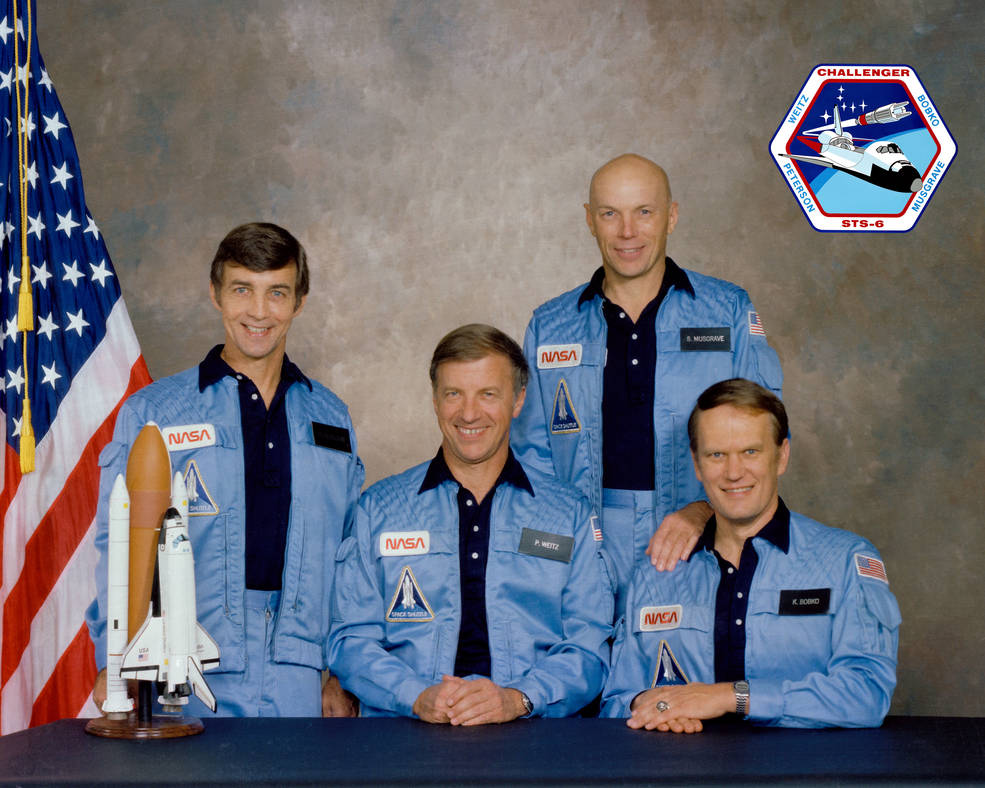
Left: The STS-6 mission patch. Right: The STS-6 crew of Donald H. Peterson, left, Paul J. Weitz, F. Story Musgrave, and Karol J. Bobko.
The four-person STS-6 crew for Challenger’s first mission included one spaceflight veteran and three first-time flyers. Selected by NASA in 1966, Weitz completed a 28-day flight aboard Skylab in 1973. Although STS-6 marked their first spaceflight, the other three astronauts all had extensive ground-based experience. Bobko and Peterson both transferred to NASA from the U.S. Air Force Manned Orbiting Laboratory astronaut program in 1969, and NASA selected Musgrave in the 1967 second class of scientist-astronauts. Bobko served as a crewmember for the 56-day Skylab Medical Experiment Altitude Test in 1972 and Musgrave served on the backup crew for the first Skylab mission.
Left: The first Tracking and Data Relay Satellite (TDRS) during preflight processing. Middle: Illustration of a TDRS as it would appear deployed in geosynchronous orbit. Right: STS-6 astronauts F. Story Musgrave, left, and Donald H. Peterson train for their spacewalk in the Weightless Environment Training Facility at NASA’s Johnson Space Center in Houston.
The primary objective for Challenger’s first crew involved the deployment of the first in a series of Tracking and Data Relay Satellites (TDRS). The TDRS System, once fully deployed, consisted of a constellation of high-capacity communications satellites in geosynchronous orbits to provide comprehensive voice and data transmissions between space shuttles – and later the International Space Station – and the Mission Control Center (MCC) at NASA’s Johnson Space Center (JSC) in Houston. Before the TDRS System became operational, communications between the ground and the Shuttle were possible for only about 15 percent of each orbit. Following deployment from the shuttle, a two-stage Inertial Upper Stage (IUS) that would boost it from low Earth orbit to geosynchronous orbit. A second major objective of STS-6 was to conduct the first spacewalk from the space shuttle, and indeed the first U.S. spacewalk since Skylab in 1974, and to test the new spacesuit developed for the shuttle program. A variety of science experiments rounded out the five-day mission.

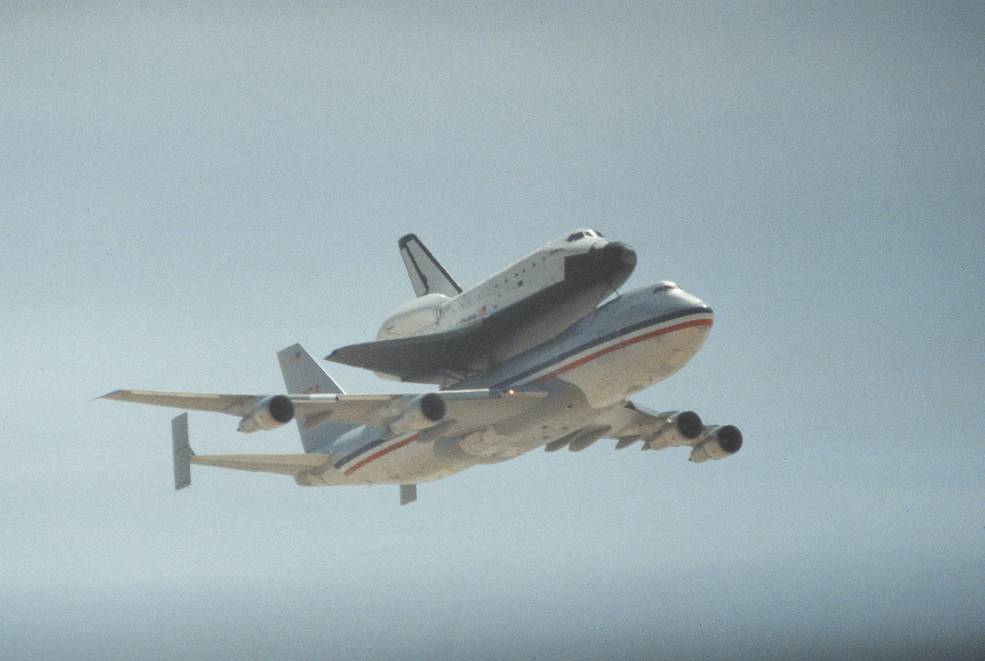

Left: Rollout of space shuttle Challenger at Rockwell International’s Palmdale, California, plant. Middle: Challenger begins its first transcontinental trip atop the Shuttle Carrier Aircraft from Edwards Air Force Base (AFB) in California. Right: Challenger during its rest stop at Houston’s Ellington AFB.
In January 1979, NASA decided to upgrade a space shuttle structural test article to its second orbital vehicle, and later announced its name as Challenger. Following completion of the vehicle, NASA rolled Challenger out to the public at Rockwell International’s Palmdale, California, facility on June 30, 1982. The next day, workers trucked it the 38 miles to Edwards Air Force Base (AFB) and mounted it atop the Shuttle Carrier Aircraft (SCA), a highly-modified Boeing 747. On July 4, shortly after the STS-4 crew landed Columbia there, President Ronald W. Reagan gave the order for Challenger to take off on its first transcontinental flight to NASA’s Kennedy Space Center (KSC) in Florida, arriving there the next day after an overnight stop at Ellington AFB in Houston. Workers towed it into KSC’s Orbiter Processing Facility (OPF) to begin preparing it for its first mission to space, STS-6, then planned for January 1983. Sister ship Columbia arrived back at KSC on July 15, and work on that vehicle took priority as engineers prepared it for STS-5 in November. This marked the first time workers simultaneously processed two orbiters for flight.

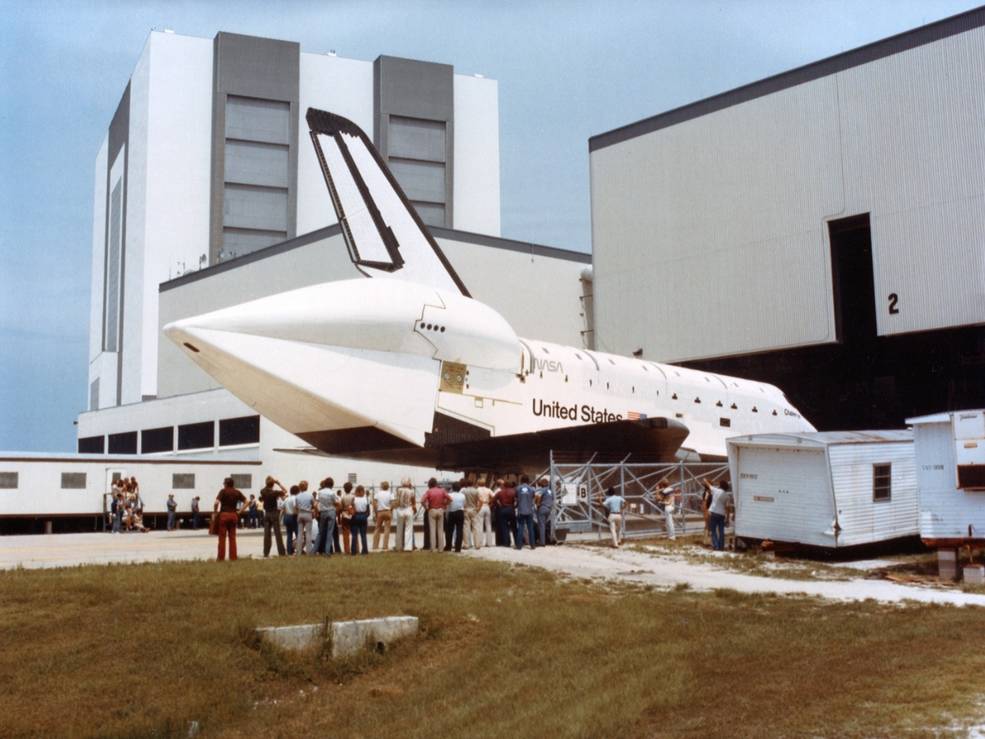
Left: Space shuttle Challenger atop its Shuttle Carrier Aircraft arrives at NASA’s Kennedy Space Center (KSC) in Florida. Right: Workers tow Challenger into KSC’s Orbiter Processing Facility.
In the nearby Vehicle Assembly Building (VAB), workers began assembling the Solid Rocket Boosters (SRBs) on Mobile Launch Platform-2, its first use in the shuttle program, completing the work on Oct. 14. They added the large orange External Tank (ET) on Oct. 21. This marked the first use of a lightweight ET, weighing about 10,000 pounds less than the tank flown on the first shuttle flight, and of lighter SRB motor casings. All these improvements resulted in an increased payload mass capability. Work in the OPF on Challenger included installation of its three main engines, upgraded to operate up to 104% thrust levels compared to Columbia’s rated to 100%, as they arrived at KSC between mid-October and mid-November. On Nov. 23, workers towed Challenger from the OPF to the VAB and mated it with the ET and SRBs. One week later, on a fog-shrouded morning, Challenger made its first trip from the VAB to Launch Pad 39A.



Left: Workers in the Vehicle Assembly Building (VAB) at NASA’s Kennedy Space Center in Florida lift space shuttle Challenger in preparation for mating with the External Tank and Solid Rocket Boosters. Middle: The space shuttle Challenger stack prepares to leave the VAB. Right: Rollout on a foggy morning of space shuttle Challenger from the VAB to Launch Pad 39A.
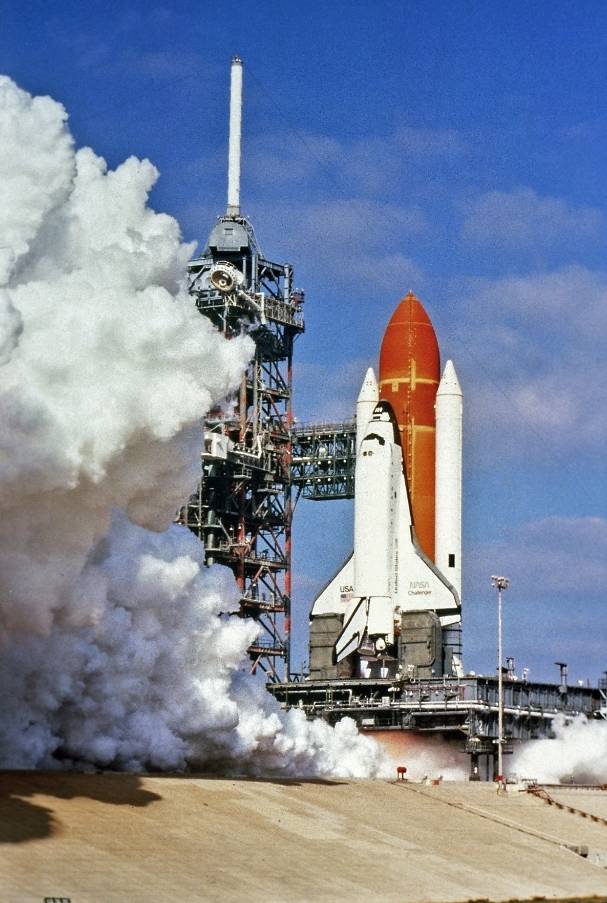
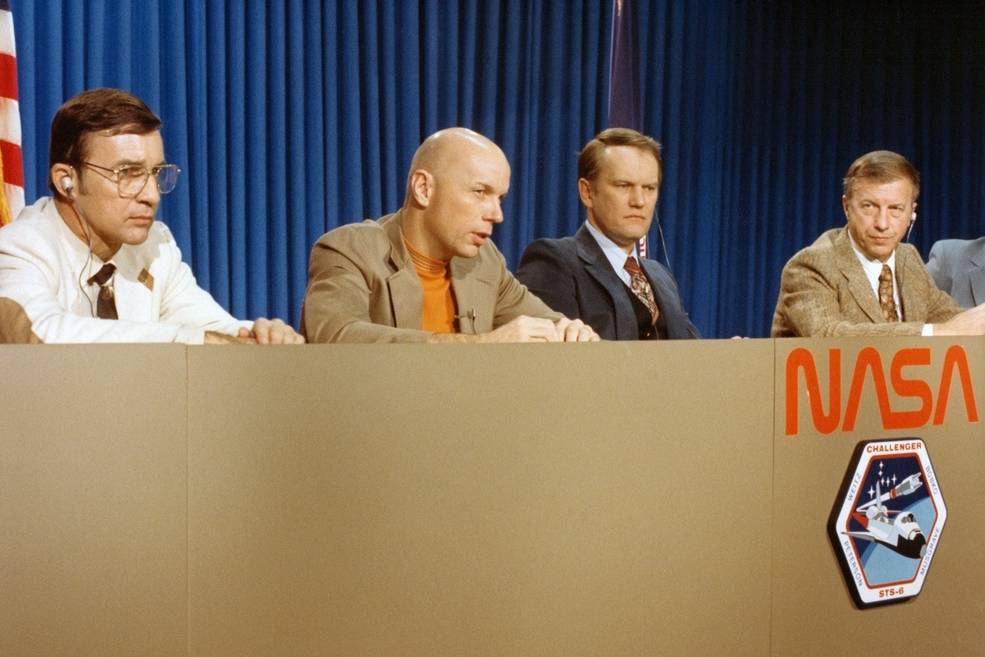

Left: Space shuttle Challenger during the first Flight Readiness Firing (FRF). Middle: STS-6 astronauts Donald H. Peterson, left, F. Story Musgrave, Karol J. “Bo” Bobko, and Paul J. Weitz answer reporters’ questions during their preflight crew press conference on Jan. 4, 1983. Right: Challenger during the second FRF.
After the failure of both spacesuits during the November STS-5 mission prevented that crew from conducting the first space shuttle spacewalk, on Dec. 17, 1982, NASA officially announced the addition of a spacewalk to STS-6. To accommodate the spacewalk, managers extended the mission from three to five days, and assigned Musgrave and Peterson to perform the task. At KSC, a 56-hour Terminal Countdown Demonstration Test (TCDT) ended on Dec. 18 with a 20-second Flight Readiness Firing (FRF) test of the three shuttle main engines. While the engines performed well, engineers noted a high concentration of hydrogen in the shuttle’s aft compartment, indicating a significant leak of the highly explosive gas. A second FRF took place on Jan. 25, and once again workers detected high levels of hydrogen. Ultimately, cracks found in all three engines required their replacement, an activity not completed until March 7 and delaying the launch to April 4. Workers transported the TDRS to the pad on Feb. 5, installing it in the payload bay on Feb. 22. Strong winds on Feb. 28 breached a containment seal, depositing fine material on the satellite that required extensive cleaning. A second TCDT on March 9 cleared the way for the countdown for launch to begin March 30, monitored by a team of engineers in Firing Room 1 of the Launch Control Center (LCC). Challenger’s crew arrived at KSC on April 1 to begin their prelaunch preparations.



Left: STS-6 astronauts Paul J. Weitz, left, Karol J. “Bo” Bobko, Donald H. Peterson, and F. Story Musgrave arrive in Florida in preparation for their launch. Middle: Bobko, left, Musgrave, Weitz, and Peterson during the traditional crew prelaunch breakfast. Right: Liftoff of Challenger on its first mission.
Following a smooth countdown, Challenger took to the skies for the first time at 1:30 p.m. EST on April 4, 1983, to begin the STS-6 mission. As soon as the shuttle cleared the launch tower, control of the mission shifted from the LCC to the MCC at JSC, where the Emerald Team of engineers led by Ascent Flight Director Jay H. Greene monitored spacecraft systems. Richard O. Covey served as the capsule communicator (capcom), a NASA astronaut who talked directly with the crew. Eight minutes 20 seconds after liftoff, Challenger and its crew reached space. Two burns of the shuttle’s two Orbiter Maneuvering System (OMS) engines ensured they achieved their operational 185-mile orbit. Soon after, the astronauts opened the payload bay doors, revealing the TDRS in the cargo bay, and some patches of thermal insulation apparently damaged during liftoff on the starboard OMS pod. Later inspections assured controllers that the damaged areas posed no concern for reentry. Flight Director Harold M. Draughon and his Crystal Team took over in the MCC, with Jon A. McBride now serving as capcom, to assist the crew with the TDRS deploy. About 10 hours into the mission, after thoroughly checking out both the TDRS and the IUS, Musgrave first titled the stack to an angle of 59 degrees and then deployed it from the cargo bay, successfully completing the flight’s primary objective. Capcom Covey read a message of congratulations to the crew, sent by President Reagan to JSC Director Gerald D. Griffin, that said in part, “On behalf of the American people, I send … our proudest congratulations on the launch of the Challenger. … You symbolize just how high America’s hopes can soar.” Near the end of the crew’s first day in orbit, Brock R. “Randy” Stone’s Amber Team took over the consoles in the MCC, with Covey back as capcom.


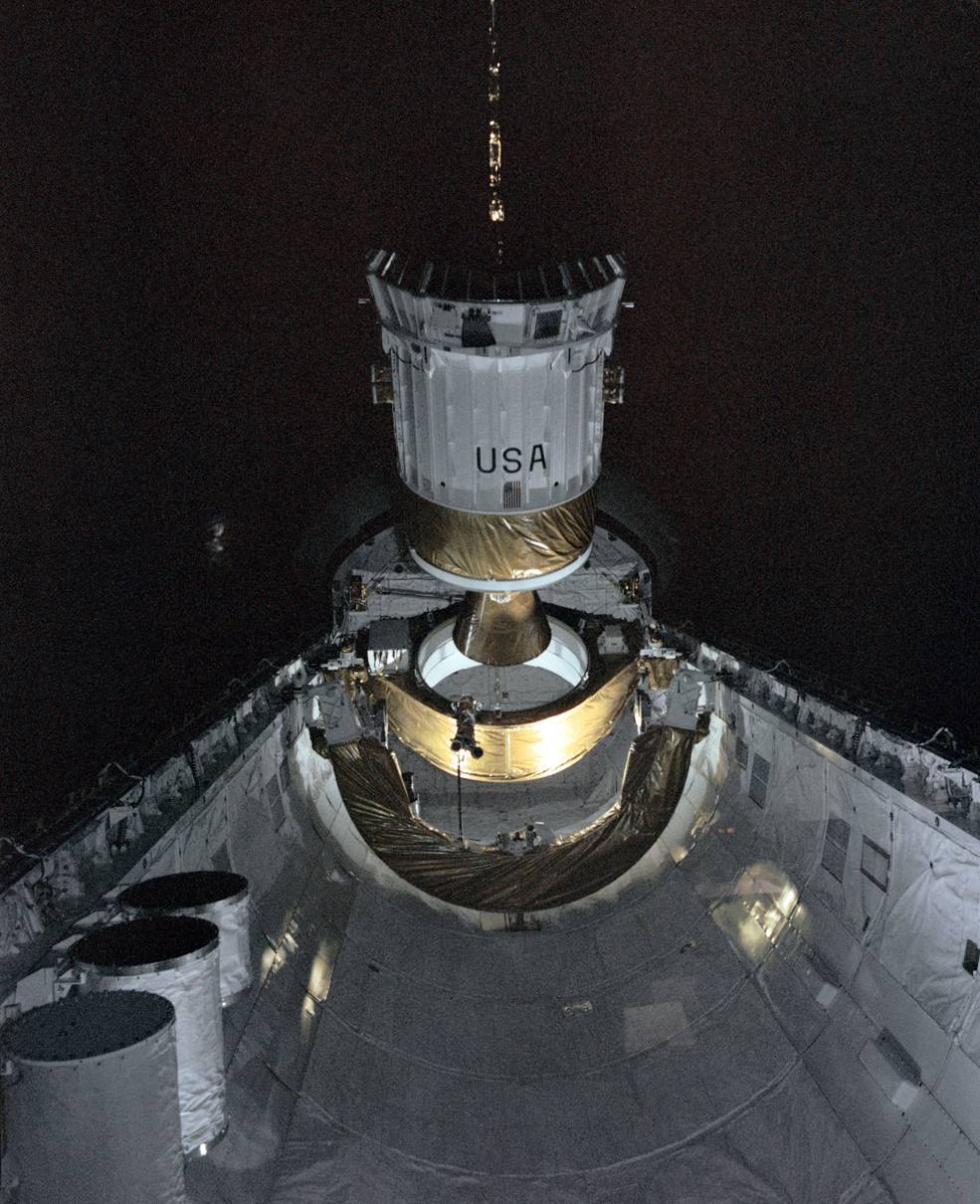

Left: View of the Tracking and Data Relay Satellite (TDRS) in Challenger’s payload bay. Middle left: The TDRS/IUS tilted up to the deploy position. Middle right: Deployment of TDRS on its IUS. Right: The TDRS/IUS as they depart from Challenger.
Although the crew’s responsibility for TDRS ended after the deploy, NASA’s responsibility ended only after the satellite reached geosynchronous orbit. Fifty-five minutes after deployment, the first stage of the IUS ignited for 2 minutes 33 seconds to place TDRS in an elliptical geosynchronous transfer orbit. However, shortly before the IUS second stage ignited, controllers lost contact with TDRS, with indications that the satellite had begun to tumble. Three hours later, the TDRS separated from the IUS second stage, stabilized itself, deployed its solar arrays and antennas, and resumed communicating with the ground. The IUS failure left TDRS in an elliptical orbit 21, 950 by 13,540 miles, from which it slowly raised itself using its own thrusters, achieving geosynchronous orbit on June 29, and its final position on Oct. 17 to support the STS-9 Spacelab 1 mission in November 1983.



Left and middle: Views of aft Reaction Control System thrusters firing. Right: F. Story Musgrave conducts the Continuous Flow Electrophoresis System (CFES) experiment on Challenger’s middeck.
Near the end of the crew’s first sleep period in space, in MCC, Flight Director Gary E. Coen and his Gray Team of controllers took their console positions, with Roy D. Bridges serving as capcom. To awaken the astronauts to begin their second day in space, MCC played the songs “Cadets on Parade” and “The Air Force Song,” played by the U.S. Air Force Academy Band. Weitz and Bobko performed the first two of five maneuvers over three days to simulate the rendezvous planned for the Solar Max satellite repair mission, accomplished during STS-41C in April 1984. They began with a maneuver using Challenger’s Reaction Control System (RCS) thrusters, followed by a burn using the two OMS engines. In the middeck, Musgrave activated the Continuous Flow Electrophoresis System (CFES) experiment, a joint effort between McDonnell Douglas Astronautics Co. of St. Louis and NASA to purify biological samples in the microgravity of space. Musgrave completed the three runs planned for the day. During a live TV downlink, Musgrave described his activities with CFES to capcom Bryan D. O’Connor. After a busy second day in space, the crew of Challenger bedded down for the night.




A sample of Earth observation photographs taken by the STS-6 crew. Left: Dakar, Senegal. Middle left: The confluence of the White Nile and the Blue Nile rivers to form the Nile River at Khartoum, Sudan. Middle right: Qatar and Bahrain. Right: Grand Bahama, left, and Great Abaco islands in The Bahamas.
Although the astronauts aboard Challenger had already started their day an hour earlier, capcom Mary L. Cleave “awakened” them to begin their third day in space with the song “Teach Me Tiger” by April Stevens. One of the first activities of the day involved Weitz and Bobko conducting the third maneuver to simulate the Solar Max rendezvous, this one a brief three-second RCS firing. Peterson activated CFES and conducted three more experiment runs, completing the experiment’s planned activities for the mission. Musgrave and Peterson began the checkout of the spacesuits for the planned spacewalk the following day, including donning them as practice for the actual event. Weitz, Bobko, and Musgrave checked out Challenger’s flight control surfaces, and all four crew members continued to take photographs of the Earth. At the end of the day, capcom Guy S. Gardner wished them a good night.

View of the Mission Control Center at NASA’s Johnson Space Center in Houston during the STS-6 spacewalk by F. Story Musgrave and Donald H. Peterson.
For the astronauts’ fourth day in space, capcom Covey played the theme song from the TV series “F-Troop,” a reference to an early crew assignment naming scheme that used letters instead of mission numbers, and Weitz’s crew was the sixth, or F-Crew. Soon the crew moved into preparations for the spacewalk, with Musgrave and Peterson in Challenger’s airlock getting their suits ready and Bobko acting as an overall spacewalk coordinator. Musgrave and Peterson donned their suits, including helmets and gloves, and after verifying the suits’ pressure integrity, began a 3.5-hour prebreathe by breathing pure oxygen to purge nitrogen from their bloodstream and prevent decompression sickness, also known as the bends. With not much to do but breathe, both Musgrave and Peterson fell asleep. During periodic TV downlinks, MCC could see the two astronauts in their white suits, with Musgrave’s sporting red bands around his legs and on his backpack for easier identification. During this time, President Reagan telephoned the astronauts from the White House to congratulate them on their mission. With their prebreathe complete, Musgrave and Peterson closed the airlock hatch to the shuttle’s middeck and began the depressurization process, first going from ambient 14.7 pounds per square inch (psi) down to 5 psi to check that the suits held pressure. Then they took the airlock down to vacuum, while their suits kept them at 4.3 psi. Musgrave opened the hatch to Challenger’s payload bay and floated out, beginning the first American spacewalk in more than nine years. For Musgrave, who had spent much of his NASA career developing spacesuits, the spacewalk represented a very personal accomplishment. Peterson followed a few minutes later.


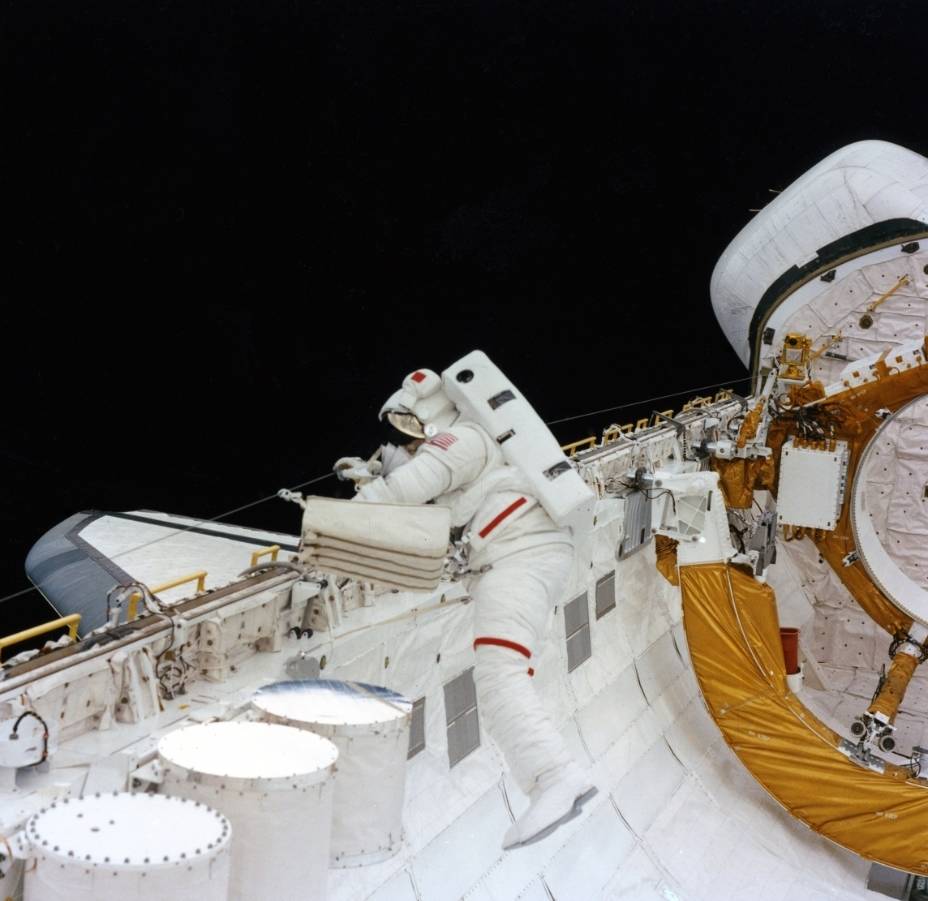
Images from the STS-6 spacewalk. Left: Astronaut F. Story Musgrave translates down the starboard sill of the payload bay. Middle: Musgrave, left, and Donald H. Peterson test tethering methods. Right: Musgrave demonstrates translating while carrying a large object.
Musgrave translated down the starboard side of the payload to the aft bulkhead as Peterson observed his movements. Peterson then translated down the port side to join Musgrave at the aft bulkhead. They inspected the damaged thermal blankets on the OMS pod then began translating forward, stopping midway, evaluating handholds as they went. Musgrave tethered himself to both port and starboard sides and moved to the center of the payload bay to evaluate whether a crew member could work efficiently that way. They both translated to the forward bulkhead to test out tools and techniques for future spacewalks, and Musgrave picked up a large toolbox and carried it to the aft bulkhead and back to demonstrate a suited crew member’s ability to move easily with a large object. That task completed, first Peterson then Musgrave reentered the airlock and closed the hatch behind them, completing a spacewalk lasting four hours and 10 minutes. They repressurized the airlock and removed their spacesuits. Capcom McBride asked Weitz to pass on to Musgrave and Peterson “they sure made our day down here …. It’s been a long time coming, this [spacewalk].” Later in the day, the astronauts completed the fourth maneuver in the rendezvous simulation, using the forward RCS thrusters. After enjoying their dinner, the astronauts turned in for the night.


Left: Vice President George H.W. Bush, right, talks to the STS-6 crew from the Mission Control Center at NASA’s Johnson Space Center in Houston as capsule communicator astronaut Roy D. Bridges looks on. Right: Still image from a TV broadcast while the astronauts chatted with Vice President Bush.
To begin the astronauts’ fifth and last full day in space, MCC played “The Poor Co-pilot,” a Korean War vintage song sung by Oscar Brand and the Roger Wilco 4, as their wakeup music. They spent much of the day cleaning up the vehicle in preparation for reentry the next day, and conducted several experiments to better understand space motion sickness. Vice President George H.W. Bush, accompanied by NASA Administrator James M. Beggs and JSC Director Gerald D. Griffin, visited MCC and spent a few minutes talking with the crew aboard Challenger. The Vice President told the astronauts, “We are certainly proud of this wonderful example you are setting. … This whole NASA operation is really inspired and, I think, brings out the best in the United States.” Weitz thanked the Vice President and added, “Hopefully this serves as a demonstration of what we can do in this country when we apply the will and the desire to do it.” During the live TV broadcast while talking with Vice President Bush, all four astronauts wore eyeglasses, a humorous tribute to their combined age of 191 years and an average age of 48.3 years, the oldest crew to have flown in space to that time. They also held up a sign that said F-Troop and another that read “111 years of aviation experience,” another reference to their ages. They conducted the fifth and final simulated rendezvous maneuver before retiring for their final night in space.
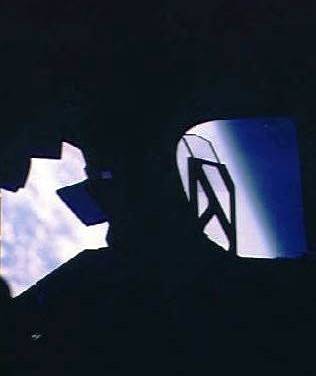
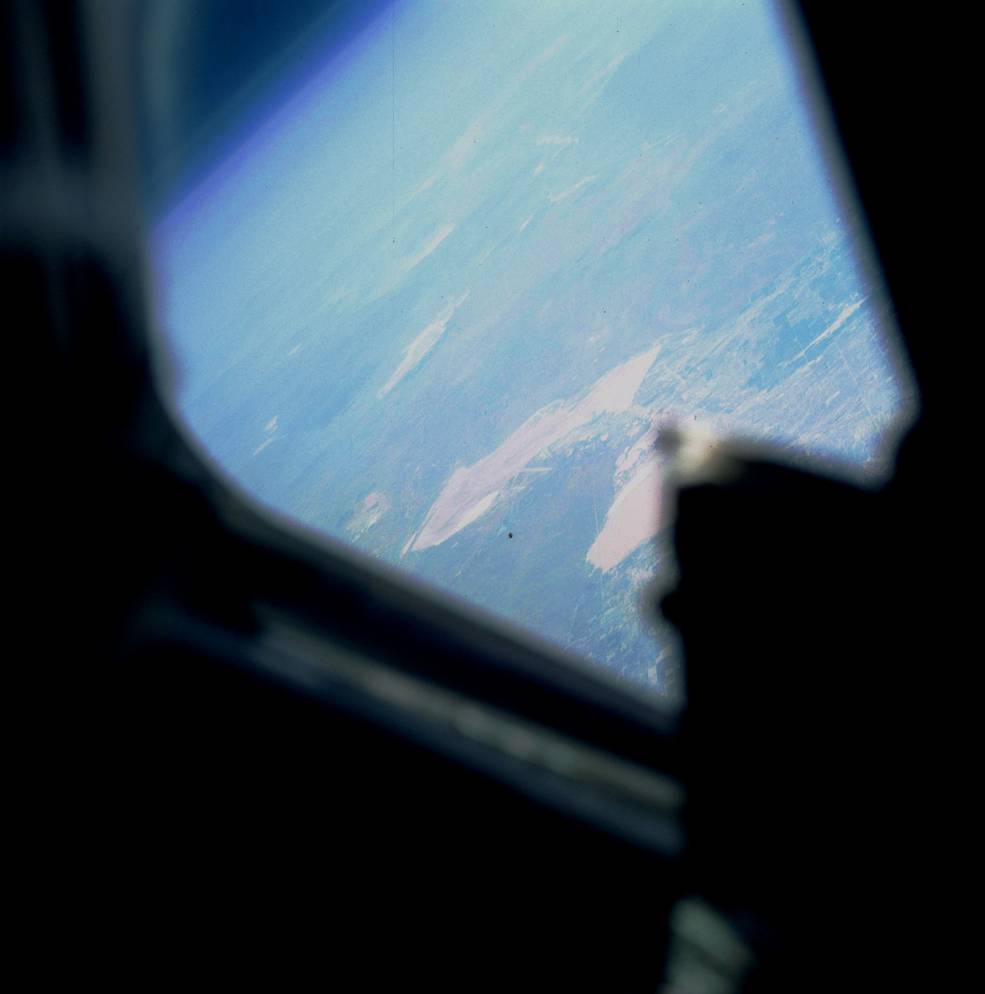


Left, middle left, and middle right: Three views taken by STS-6 astronaut F. Story Musgrave during space shuttle Challenger’s reentry and approach to Edwards Air Force Base in California. Right: Challenger touches down on the runway at Edwards to end the STS-6 mission.
On April 9, Entry Flight Director Coen’s Gray Team of controllers took their consoles for the final few hours of Challenger’s first mission. For their last wake up call, capcom O’Connor played “Ode to the Lions,” as rendered by Rusty Gordon, a song from Penn State University, Weitz’s alma mater. After breakfast, the astronauts closed the payload bay doors and began donning their personal equipment such as harnesses and boots for the reentry. Over the Indian Ocean on the mission’s 80th orbit, Weitz and Bobko oriented Challenger with its tail flying forward and ignited its two OMS engines for two and a half minutes to slow their velocity to begin their return to Earth. They turned Challenger around so it flew nose first and angled up about 40 degrees. Challenger encountered the first tendrils of the Earth’s upper atmosphere at an altitude of 400,000 feet. The heat of reentry caused a sheath of ionized plasma to form around the vehicle, temporarily blocking communications. Weitz flew Challenger through a series of hypersonic and supersonic maneuvers to get more data on the shuttle’s handling in those regimes. At an altitude of 40,000 feet, Challenger’s velocity dropped below the speed of sound, treating the thousands of spectators to the now-familiar double sonic boom, announcing the shuttle’s arrival to Edwards AFB. After making a final turn, Weitz aligned Challenger with the concrete runway, the lakebed having been soaked by days of rain, and brought the orbiter down, first the main and then the nose gear touching the runway. After a rollout of 7,300 feet, Challenger came to a stop, ending a mission lasting 5 days 0 hours and 24 minutes.




Left: In the Mission Control Center at NASA’s Johnson Space Center in Houston, Director of Mission Operations Eugene F. Kranz, left, congratulates Entry Flight Director Gary E. Coen following the successful landing of space shuttle Challenger, ending the STS-6 mission. Middle left: STS-6 astronauts Karol J. Bobko, left, Donald H. Peterson, F. Story Musgrave, and Paul J. Weitz disembark from Challenger following their landing at Edwards Air Force Base (AFB) in California. Middle right: A crowd of well-wishers welcomes Weitz, left, Bobko, Musgrave, and Peterson to Ellington AFB in Houston. Right: Peterson, left, Musgrave, Bobko, and Weitz during the postflight crew press conference.
After exiting Challenger, Weitz, Bobko, Musgrave, and Peterson conducted a brief walkaround of the orbiter to inspect it for any damage. After a brief ceremony at the Dryden (now Armstrong) Flight Research Center, the astronauts boarded a plane for the flight back to Houston’s Ellington AFB near JSC, where a large crowd of well-wishers greeted them. On April 22, the STS-6 crew held a press conference, during which they narrated a film about their mission and answered reporters’ questions. Meanwhile at Edwards, ground crews towed Challenger from the runway to the Mate Demate Device (MDD) for a postflight inspection, finding it in excellent shape. They mounted the orbiter atop the SCA for the ferry flight back to KSC. After an overnight stop at Kelly AFB in San Antonio, Challenger atop the SCA made low passes over Houston and JSC before flying on to Florida, arriving there on April 16. In KSC’s OPF, workers prepared Challenger for its next historic mission, STS-7, planned for June 1983.
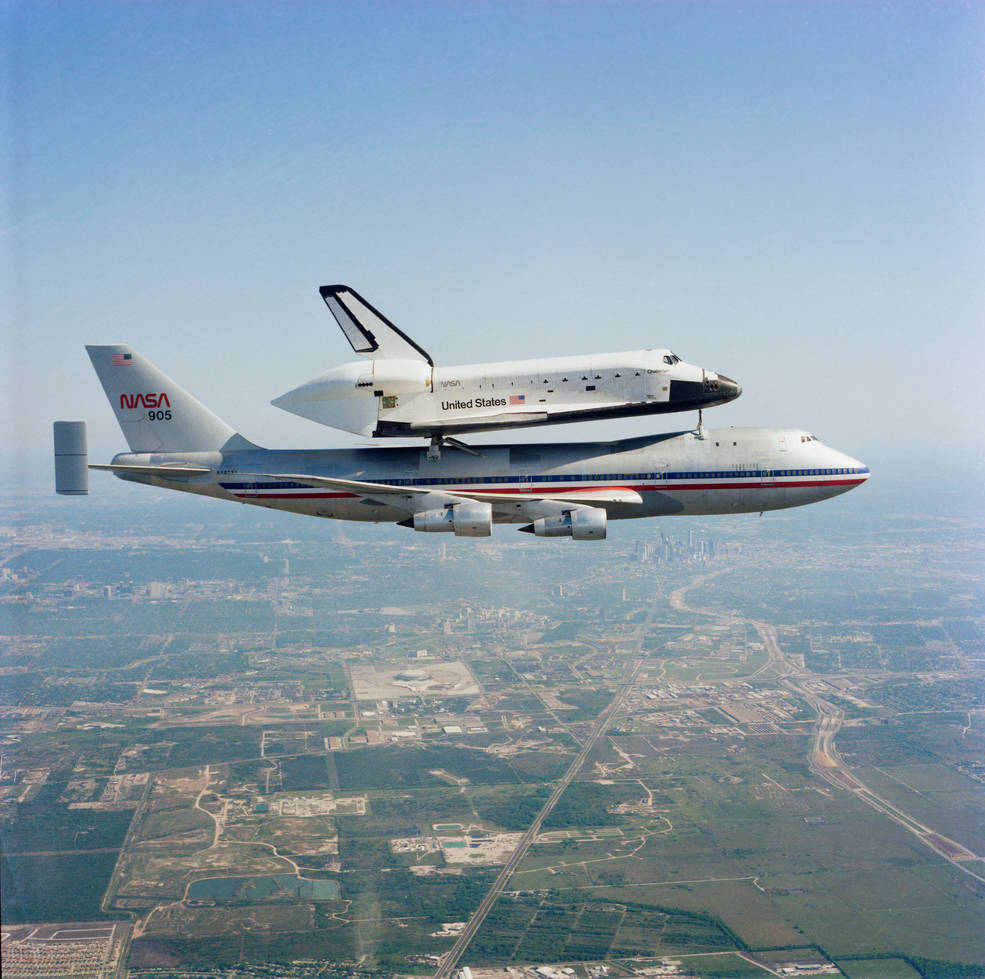




Left: Space shuttle Challenger atop the Shuttle Carrier Aircraft (SCA) depart Edwards Air Force Base in California for the ferry flight back to NASA’s Kennedy Space Center in Florida. Middle: Challenger atop the SCA flies over Houston. Right: Challenger atop the SCA flies over NASA’s Johnson Space Center in Houston.
John Uri
NASA Johnson Space Center
























